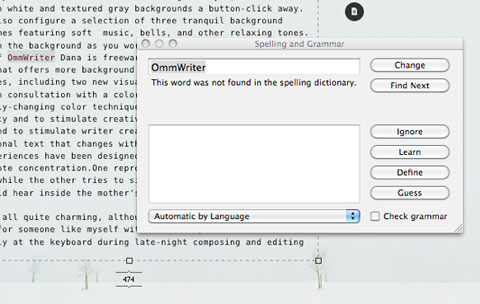
As the name suggests, Collections are just a way of storing different lists of documents. (Talking of QuickLook, the QuickLook panel is available in Scrivener 2.0 on Snow Leopard for documents that Scrivener can’t display itself - you can import any file type in Scrivener 2.0.) You can now open any number of documents from your project in separate QuickReference panels:Ĭollections provide another way of organising documents in Scrivener and they can temporarily replace the binder in the sidebar. Wait, what are QuickReference panels, you ask?
Ommwriter rtf full#
However, in Scrivener 2.0 you may want to have other documents open in QuickReference panels while in full screen mode, and these would work well on another blanked-out screen.

I’ve always been very much against this in the past, simply because I strongly believe that if you aren’t using the extra screens then they should be turned off. Oh, and you can also choose to have other screens blanked out while in full screen mode now, too. I was quite miffed when Ommwriter beat us to the punch on this one.) (And no, I didn’t borrow this feature from the lovely Ommwriter - it’s actually been sitting in our internal version of Scrivener for two years. Let’s start with a general screenshot, given that Scrivener 2.0 has had a facelift: For once, I’m not going to be too verbose in this post (EDIT: It turns out I was verbose after all - sorry about that) instead I’m going to let screenshots do most of the talking. But that’s all I wanted to say, really: that the way I see Scrivener 2.0 is that it is Scrivener the way it should be. Well, you don’t want a preamble, do you? You just want me to get to the features. Since Scrivener 1.0 came out of its (two-year-) long public beta and went on sale in January 2007, user feedback and my own constant use of Scrivener have made it obvious where things could be done better. But because it was doing something new, and because I am hardly a design or coding genius, there were areas that could have worked together better.
Ommwriter rtf software#
Scrivener 1.0 tried to do something new in the way it integrated various established tools (and I must have done something right because there are now a number of imitators on Windows and many features have been co-opted into certain other software on the Mac, too). It’s fair to say that Scrivener 2.0 is very much a product of user feedback. And yes, that’s my way of saying that you won’t find anything particularly whizz-bang in this list - but you should see a solid set of features that you will find useful in the endeavour for which Scrivener was designed: writing. So, I make no apology for concentrating on the core features rather than trying to shoehorn in features I don’t think belong. I always think very carefully before adding new features - it’s impossible to please everybody because every user has something different on his or her wish list, and if you try you just end up with software that is bloated and difficult to use.

Right upfront I ought to say that the focus has been very much on improving Scrivener’s existing feature-set by better integrating various aspects of the interface and making Scrivener easier and more pleasurable to use in general. Now it’s time to talk about some of the goodies that are coming.

This is how far to indent the first line of new paragraphs.Ĭonst rtfToHTML = require('rtf-to-html/rtf-to-html.js') rtfToHTML(doc) → HTML


 0 kommentar(er)
0 kommentar(er)
